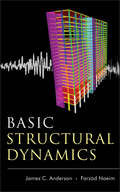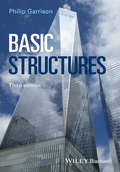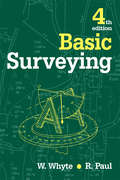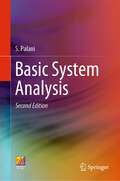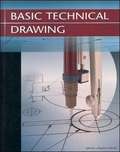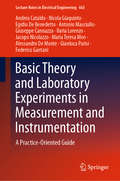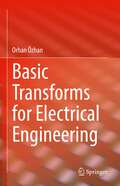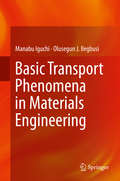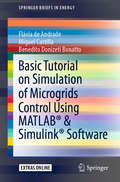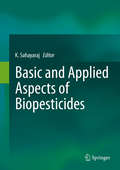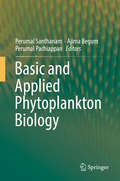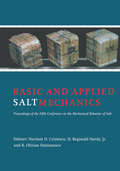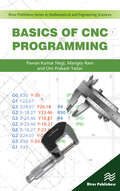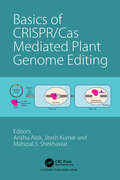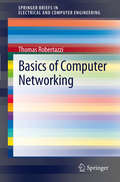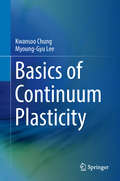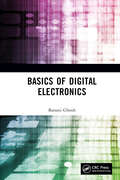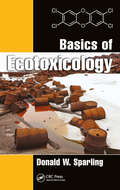- Table View
- List View
Basic Structural Dynamics
by Farzad Naeim James C. AndersonA concise introduction to structural dynamics and earthquake engineeringBasic Structural Dynamics serves as a fundamental introduction to the topic of structural dynamics. Covering single and multiple-degree-of-freedom systems while providing an introduction to earthquake engineering, the book keeps the coverage succinct and on topic at a level that is appropriate for undergraduate and graduate students. Through dozens of worked examples based on actual structures, it also introduces readers to MATLAB, a powerful software for solving both simple and complex structural dynamics problems.Conceptually composed of three parts, the book begins with the basic concepts and dynamic response of single-degree-of-freedom systems to various excitations. Next, it covers the linear and nonlinear response of multiple-degree-of-freedom systems to various excitations. Finally, it deals with linear and nonlinear response of structures subjected to earthquake ground motions and structural dynamics-related code provisions for assessing seismic response of structures. Chapter coverage includes:Single-degree-of-freedom systemsFree vibration response of SDOF systemsResponse to harmonic loadingResponse to impulse loadsResponse to arbitrary dynamic loadingMultiple-degree-of-freedom systemsIntroduction to nonlinear response of structuresSeismic response of structuresIf you're an undergraduate or graduate student or a practicing structural or mechanical engineer who requires some background on structural dynamics and the effects of earthquakes on structures, Basic Structural Dynamics will quickly get you up to speed on the subject without sacrificing important information.
Basic Structures
by Philip GarrisonBasic Structures provides the student with a clear explanation of structural concepts, using many analogies and examples. Real examples and case studies show the concepts in use, and the book is well illustrated with full colour photographs and many line illustrations, giving the student a thorough grounding in the fundamentals and a 'feel' for the way buildings behave structurally. With many worked examples and tutorial questions, the book serves as an ideal introduction to the subject.
Basic Surveying
by Raymond Paul Walter WhyteThe primary aim of this book is to provide a guide to current practice and equipment for non-specialist surveyors in the various professions involved in the construction industry and the environment. It is suitable for students preparing for degrees and diplomas in architecture, building, building surveying, quantity surveying, estate management and town planning and environmental studies. It is also of value to engineers who are not specialising in engineering surveying.This book has been thoroughly revised to include new topics such as OS digital mapping, standard deviation and standard error, global positioning systems, transition and vertical curves.Walter Whyte was born in New Zealand of Scottish parents and educated in Scotland. He worked on site and building surveys in Scotland. He worked on site and building surveys in Scotland, then on road survey and setting out in the North Nyanza and Uasin Gishu Provinces of Kenya, and as a road engineer in British Southern Cameroons and Northern Nigeria, De Montford University in the UK and latterly at City University, Hong Kong.Raymond E Paul has been professionally involved in surveying for over 40 years as a land and cartographical surveyor, senior lecturer and author. He has a wealth of practical experience and an awareness of the needs of the intended users of this book from all corners of the globe.
Basic System Analysis
by S. PalaniThe book provides a comprehensive introduction to all major topics in Basic System Analysis. The book is designed to serve as a textbook for courses offered to undergraduate students enrolled in electrical, electronics, and communication engineering disciplines. It provides a clear and comprehensive treatment of continuous-time signals and systems with numerical examples; discusses the Fourier series and Fourier transform at length with numerical examples; includes an extensive application of the Laplace transform method of analysis of the linear time-invariant system, etc. The text is augmented with many illustrative examples for easy understanding of the topics covered. Every chapter contains several numerical problems with answers followed by question-and-answer type assignments. The detailed coverage and pedagogical tools make this an ideal textbook for students and researchers enrolled in electrical engineering and related programs.
Basic Technical Drawing (8th Edition)
by Henry Cecil Spencer John Thomas Dygdon James E. NovakBasic Technical Drawing is a classroom textbook and reference book for the beginning student of technical drawing. It provides essential information as clearly and completely as possible in straightforward language and with ample illustrations. This new edition provides updated information on the basics of technical drawing; yet it retains the practical focus and open format that have made it popular with thousands of students.
Basic Techniques in Biochemistry, Microbiology and Molecular Biology: Principles and Techniques (Springer Protocols Handbooks)
by Aakanchha Jain Richa Jain Sourabh JainThis book presents key methodologies, tools and databases for biochemistry, microbiology and molecular biology in simple and straightforward language. Covering all aspects related to experimental principles and procedures, the protocols included here are brief and clearly defined, and include essential precautions to be taken while conducting experiments. The book is divided into two major sections: one on constructing, working with, and standard operating procedures for laboratory instruments; and one on practical procedures used in molecular biology, microbiology and biochemical analysis experiments, which are described in full. Each chapter describes both the basic theory and relevant practical details for a given experiment, and helps readers recognize both the experiment’s potential and limitations. Intended as an intensive introduction to the various tools used in molecular biology, the book covers all basic methods and equipment, including cloning, PCR, spectrophotometers, ELISA readers, sonicators, etc. As such, it offers a valuable asset for final year undergraduate (especially project) students, graduate research students, research scientists and technicians who wish to understand and employ new techniques in the field of biotechnology.
Basic Theory and Laboratory Experiments in Measurement and Instrumentation: A Practice-Oriented Guide (Lecture Notes in Electrical Engineering #663)
by Andrea Cataldo Nicola Giaquinto Antonio Masciullo Giuseppe Cannazza Ilaria Lorenzo Jacopo Nicolazzo Maria Teresa Meo Gianluca Parisi Federico Gaetani Egidio De Benedetto Alessando De MonteThis textbook offers a unique compendium of measurement procedures for experimental data acquisition. After introducing readers to the basic theory of uncertainty evaluation in measurements, it shows how to apply it in practice to conduct a range of laboratory experiments with instruments and procedures operating both in the time and frequency domains. Offering extensive practical information and hands-on tips on using oscilloscopes, spectrum analyzers and reflectometric instrumentation, the book shows readers how to deal with e.g. filter characterization, operational amplifiers, digital and analogic spectral analysis, and reflectometry-based measurements. For each experiment, it describes the corresponding uncertainty evaluation in detail. Bridging the gap between theory and practice, the book offers a unique, self-contained guide for engineering students and professionals alike. It also provides university teachers and professors with a valuable resource for their laboratory courses on electric and electronic measurements.
Basic Transforms for Electrical Engineering
by Orhan ÖzhanThe textbook covers the most popular transforms used in electrical engineering along with the mathematical foundations of the transforms, uniquely bringing together the two in a single text. Geared towards an upper-undergraduate or graduate-level class, the book covers the most-used transforms including Fourier, Laplace, Discrete Fourier, z-, short-time Fourier, and discrete cosine transforms. The book includes the complex numbers, complex functions, and complex integration that are fundamental to understand the transforms. The author strives to make the study of the subject approachable by appealing to the use of popular software like LabVIEW virtual instruments, Matlab m-files, and C programming resources. Computer projects at the end of chapters further enhance the learning process. The book is based on the author’s years of teachıng Engineering Mathematics and Signal courses and can be used in both electrical engineering and mathematics curriculum.Presents both electrical engineering transforms and their mathematical foundations in an understandable, pedagogical, and applicable approach;Covers the most common transforms for electronics and communications engineers including Laplace transform, the Fourier transform, STFT, the z-transform;Features LabVIEW virtual instrument (vi) files, LTSpice simulation files, MATLAB m files, and computer projects in the chapter problems.
Basic Transport Phenomena in Biomedical Engineering (Fourth Edition)
by Ronald L. FournierThis will be a substantial revision of a good selling text for upper division/first graduate courses in biomedical transport phenomena, offered in many departments of biomedical and chemical engineering. Each chapter will be updated accordingly, with new problems and examples incorporated where appropriate. A particular emphasis will be on new information related to tissue engineering and organ regeneration. A key new feature will be the inclusion of complete solutions within the body of the text, rather than in a separate solutions manual. Also, Matlab will be incorporated for the first time with this Fourth Edition.
Basic Transport Phenomena in Materials Engineering
by Manabu Iguchi Olusegun J. IlegbusiThis book presents the basic theory and experimental techniques of transport phenomena in materials processing operations. Such fundamental knowledge is highly useful for researchers and engineers in the field to improve the efficiency of conventional processes or develop novel technology. Divided into four parts, the book comprises 11 chapters describing the principles of momentum transfer, heat transfer, and mass transfer in single phase and multiphase systems. Each chapter includes examples with solutions and exercises to facilitate students' learning. Diagnostic problems are also provided at the end of each part to assess students' comprehension of the material. The book is aimed primarily at students in materials science and engineering. However, it can also serve as a useful reference text in chemical engineering as well as an introductory transport phenomena text in mechanical engineering. In addition, researchers and engineers engaged in materials processing operations will find the material useful for the design of experiments and mathematical models in transport phenomena. This volume contains unique features not usually found in traditional transport phenomena texts. It integrates experimental techniques and theory, both of which are required to adequately solve the inherently complex problems in materials processing operations. It takes a holistic approach by considering both single and multiphase systems, augmented with specific practical examples. There is a discussion of flow and heat transfer in microscale systems, which is relevant to the design of modern processes such as fuel cells and compact heat exchangers. Also described are auxiliary relationships including turbulence modeling, interfacial phenomena, rheology, and particulate systems, which are critical to many materials processing operations.
Basic Tutorial on Simulation of Microgrids Control Using MATLAB® & Simulink® Software (SpringerBriefs in Energy)
by Miguel Castilla Benedito Donizeti Bonatto Flávia de AndradeThis book offers a detailed guide to the design and simulation of basic control methods applied to microgrids in various operating modes, using MATLAB® Simulink® software. It includes discussions on the performance of each configuration, as well as the advantages and limitations of the droop control method. The content is organised didactically, with a level of mathematical and scientific rigour suitable for undergraduate and graduate programmes, as well as for industry professionals. The use of MATLAB® Simulink® software facilitates the learning process with regard to modelling and simulating power electronic converters at the interface of distributed energy resource (DER) systems. The book also features a wealth of illustrations, schematics, and simulation results. Given its scope, it will greatly benefit undergraduate and graduate students in the fields of electrical and electronics engineering, as well as professionals working in microgrid design and implementation.
Basic Welding for Farm and Ranch: Essential Tools and Techniques for Repairing and Fabricating Farm Equipment
by William GalveryFarmers, ranchers, and homesteaders who know how to weld can repair and even fabricate some equipment on their own, saving both time and money. Basic Welding for Farm and Ranch introduces this crucial skill and covers the most popular techniques used by the home hobbyist and DIY devotee, with chapters and detailed illustrations dedicated to oxyacetylene welding (or gas welding), stick welding, MIG, and arc welding, as well as brazing and soldering. Along with guidance on equipment selection and use, and safety precautions, this book offers 12 projects and repairs commonly faced on the small farm or homestead, with step-by-step photography guiding readers through building a wall-mount hay feeder, repairing a garden rake, making horseshoe hooks, and more. This publication conforms to the EPUB Accessibility specification at WCAG 2.0 Level AA.
Basic and Applied Aspects of Biopesticides
by K. SahayarajCurrently, the major challenge of humanity is focused on population growth through agricultural production in order to meet the demand for food. The food crunch is mainly due to pest and disease. Traditional methods, synthetic insecticides and microbicides cause health hazards to human beings, domestic animals and also affect our immediate environments. Serious concerns were implemented by both developing and developed countries as Integrated Pest Management (IPM) and Bio-intensive Integrated Pest Management (BIPM) systems where biopesticides play an important role worldwide. The available books are limited to particular aspects of biopesticides. Hence, it is imperative to bring out a holistic documentation which will provide the reader information on all aspects of biopesticides. The book consists of five sections namely microbials, botanicals, natural enemies semio- chemicals and biotechnology and equipments, bioinformatics tools and IPM. In Section I, microbial deals with utilization of Bacillus in control of phytonematodes; biological control of pest and diseases with fluorescent pseudomonads, entomopathogenic fungus and entomopathogenic nematodes in pest management, microbial viral insecticides and microbial elicitors to induce immunity for plant disease control in chilli and tomato. Importance of plant essential oils, botanicals in endocrine disruption, relevance of botanicals and use of plant volatile on pest management has been discussed in Section II. Importance and role of reduviidae, weaver ants, ground beetles, Odonatas, spiders in biological control has been discussed in Section III. In addition, genetic improvement of biocontrol agents for sustainable pest management has also been highlighted. In Section IV, classical practices and pheromone, kairomonal enhancement to natural enemies and use of transgenic plants in insect control are highlighted. Equipment and their application methodologies for application of biopesticides; relevance of bioinformatics in biopesticides management; pest management of soybean, bio fouling and eco friendly antifoulants have been highlighted in Section V. Each chapter has objectives and conclusion along with recommendations.
Basic and Applied Aspects: Proceedings of the 21st Annual and International Meeting of the Japanese Association for Animal Cell Technology (JAACT), Fukuoka, Japan, November 24-27, 2008 (Animal Cell Technology: Basic & Applied Aspects #16)
by Masamichi Kamihira Akira Ito Yoshinori KatakuraAnimal cell technology is a growing discipline of cell biology which aims not only to understand the structure, function and behavior of differentiated animal cells, but also to ascertain their ability to be used for industrial and medical purposes. Some of the major goals of animal cell technology include: the clonal expansion of differentiated cells, the optimization of their culture conditions, modulation of their ability for the production of medically and pharmaceutically important proteins and the application of animal cells to gene therapy, artificial organs and functional foods. This volume gives the readers a complete review of the present state-of-the-art research in Japan and other countries where this field is well advanced. The Proceedings will be useful to cell biologists, biochemists, molecular biologists, immunologists, biochemical engineers and to those working in either academic environments or in the biotechnology and pharmacy industries related to animal cell culture.
Basic and Applied Phytoplankton Biology
by Perumal Pachiappan Perumal Santhanam Ajima BegumThis book presents the latest developments and recent research trends in the field of plankton, highlighting the potential ecological and biotechnological applications. It critically and comprehensively discusses strain selection, growth characteristics, large-scale culturing, and biomass harvesting, focusing on the screening and production of high-value products from algae, and evaluating carbon dioxide sequestration from fuel gas as a climate change mitigation strategy. The latter areas of research are clearly central to the sustainable development approach that is currently attracting global attention.Over the decades, much of the literature on has focused on the biological and ecological aspects of phytoplankton found in freshwater, marine and brackish water environments. However, these organisms are known to also inhabit various other environments. More recently, there has been a substantial shift toward the concept of sustainable development and the “green economy” with emphasis on exploiting biological systems for the benefit of mankind. The significance of these plankton cannot be underestimated as they contribute approximately 40% of the oxygen in the atmosphere. Therefore, there is potential for exploitation of this invaluable biomass source that could lead to significant environmental and economic benefits for man.Providing a comprehensive outline of the most recent developments and advances in the field of industrial applications of these plankton, this book is an excellent reference resource for researchers and practitioners.
Basic and Applied Salt Mechanics: Proceedings of the 5th Conference on Mechanical Behaviour of Salt, Bucharest, 9-11 August 1999
by N. D. CristescuPapers cover: laboratory and in-situ testing; coupled effects and permeability; creep damage and dilatancy; constitutive modelling; crushed salt behaviour; numerical modelling; storage and disposal projects; mining applications; case studies; and salt pillars and cavities.
Basic and Applied Zooplankton Biology
by Perumal Pachiappan Perumal Santhanam Ajima BegumThe coastal and ocean ecosystem is a significant feature of our planet and provides a source of food for much of life on Earth. Millions of species have been, and are still being discovered in the world’s oceans. Among these zooplankton serve as secondary producers and are significant as they form pelagic food links and act as indicators of water masses. They constitute the largest and most reliable source of protein for most of the ocean’s fishes. As such, their absence or depletion often affects fishery. In many countries, the decline in fishery has been attributed to reduced plankton populations. Furthermore, trillions of tiny copepods produce countless faecal pellets contributing greatly to the marine snow and therefore accelerating the flow of nutrients and minerals from the surface waters to the seabed. They are phylogenetically highly successful groups in terms of phylogenetic age, number of living species and success of adaptive radiation. A study of the basic and applied aspects of zooplankton would provide an index of the fishery potential and applications, offering insights into ocean ecology to safeguard food supplies and livelihoods of the millions of people living in coastal areas. For this reason, we need to understand all the facets of zooplankton as well as their interactions with atmosphere and other life forms, including human. In this context, this book discusses the basic and applied aspects of zooplankton, especially taxonomy, mosquitocidal activity, culture, analysis of nutritional, pigments and enzyme profile, preservation of copepods eggs, bioenrichment of zooplankton and application of zooplankton in sustainable aquaculture production, focusing on novel biofloc-copefloc technologies, and the impact of acidification and microplastics on zooplankton.Offering a comprehensive overview of the current issues and developments in the field of environmental and commercial applications, this book is a valuable resource for researchers, aquaculturists, environmental mangers wanting to understand the importance of zooplankton and develop technologies for the sustainable production of fish and other commodities to provide food and livelihoods for mankind.
Basics of CNC Programming
by Mangey Ram Om Prakash Yadav Pawan NegiBefore the introduction of automatic machines and automation, industrial manufacturing of machines and their parts for the key industries were made though manually operated machines. Due to this, manufacturers could not make complex profiles or shapes with high accuracy. As a result, the production rate tended to be slow, production costs were very high, rejection rates were high and manufacturers often could not complete tasks on time.Industry was boosted by the introduction of the semi-automatic manufacturing machine, known as the NC machine, which was introduced in the 1950’s at the Massachusetts Institute of Technology in the USA. After these NC machine started to be used, typical profiles and complex shapes could get produced more readily, which in turn lead to an improved production rate with higher accuracy.Thereafter, in the 1970’s, an even larger revolutionary change was introduced to manufacturing, namely the use of the CNC machine (Computer Numerical Control). Since then, CNC has become the dominant production method in most manufacturing industries, including automotive, aviation, defence, oil and gas, medical, electronics industry, and the optical industry. Basics of CNC Programming describes how to design CNC programs, and what cutting parameters are required to make a good manufacturing program. The authors explain about cutting parameters in CNC machines, such as cutting feed, depth of cut, rpm, cutting speed etc., and they also explain the G codes and M codes which are common to CNC. The skill-set of CNC program writing is covered, as well as how to cut material during different operations like straight turning, step turning, taper turning, drilling, chamfering, radius profile, profile turning etc. In so doing, the authors cover the level of CNC programming from basic to industrial format. Drawings and CNC programs to practice on are also included for the reader.
Basics of CRISPR/Cas Mediated Plant Genome Editing
by Anshu Alok Jitesh Kumar Mahipal S. ShekhawatCRISPR/Cas has emerged, as a powerful genetic engineering tool. It is simple yet highly affordable and robust. This book provides a basic introduction to the mechanism and architecture of the CRISPR/Cas. It enlightens the readers about the new advancements such as gene insertion, transcriptional activation, suppression, gene tagging, multiplexing, base editing, prime editing, and tissue culture free editing which makes it easier for crop improvement. With such technologies, application of genome editing has opened new paths for crop improvements and sustainable agriculture. The current book will be useful for beginners to understand these tools and how to use them in a better and more efficient way.
Basics of Computer Hardware (OE-101-ELS) First Semester FYBA, B.COM New NEP Syllabus - SPPU
by Prof. Dr. P. B. Buchade Prof. Dr. M. L. Dongare S. R. Chaudhari Ms Shital KanasakarA textbook on Basics of Computer Hardware designed for undergraduate students as per the National Education Policy (NEP) syllabus. It offers an introduction to computer fundamentals, including computer components, microprocessors, memory, and peripherals. Topics range from defining and classifying computers to explaining microprocessors' working, motherboard architecture, and input/output devices. With diagrams, examples, and exercises, the book simplifies complex concepts for beginners, preparing them for careers in electronics and related fields.
Basics of Computer Networking (SpringerBriefs in Electrical and Computer Engineering)
by Thomas RobertazziSpringer Brief Basics of Computer Networking provides a non-mathematical introduction to the world of networks. This book covers both technology for wired and wireless networks. Coverage includes transmission media, local area networks, wide area networks, and network security. Written in a very accessible style for the interested layman by the author of a widely used textbook with many years of experience explaining concepts to the beginner.
Basics of Continuum Plasticity
by Kwansoo Chung Myoung-Gyu LeeThis book describes the basic principles of plasticity for students and engineers who wish to perform plasticity analyses in their professional lives, and provides an introduction to the application of plasticity theories and basic continuum mechanics in metal forming processes. This book consists of three parts. The first part deals with the characteristics of plasticity and instability under simple tension or compression and plasticity in beam bending and torsion. The second part is designed to provide the basic principles of continuum mechanics, and the last part presents an extension of one-dimensional plasticity to general three-dimensional laws based on the fundamentals of continuum mechanics. Though most parts of the book are written in the context of general plasticity, the last two chapters are specifically devoted to sheet metal forming applications. The homework problems included are designed to reinforce understanding of the concepts involved. This book may be used as a textbook for a one semester course lasting fourteen weeks or longer. This book is intended to be self-sufficient such that readers can study it independently without taking another formal course. However, there are some prerequisites before starting this book, which include a course on engineering mathematics and an introductory course on solid mechanics.
Basics of Cutting and Abrasive Processes (Lecture Notes in Production Engineering)
by Berend Denkena Hans Kurt ToenshoffManufacturing is the basic industrial activity generating real value. Cutting and abrasive technologies are the backbone of precision production in machine, automotive and aircraft building as well as of production of consumer goods. We present the knowledge of modern manufacturing in these technologies on the basis of scientific research. The theory of cutting and abrasive processes and the knowledge about their application in industrial practice are a prerequisite for the studies of manufacturing science and an important part of the curriculum of the master study in German mechanical engineering. The basis of this book is our lecture "Basics of cutting and abrasive processes" (4 semester hours/3 credit hours) at the Leibniz University Hannover, which we offer to the diploma and master students specializing in manufacturing science.
Basics of Digital Electronics
by Banani GhoshThis book contains short definitions and descriptions followed by examination material for Digital Electronics. The topics included are: Analog and Digital Signals Number Systems Combinational Logic Circuits Multiplexer, Demultiplexer, Encoder, Decoder Binary Arithmetic Digital Logic Families Different Types of Displays Print edition not for sale in South Asia (India, Sri Lanka, Nepal, Bangladesh, Pakistan or Bhutan)
Basics of Ecotoxicology
by Donald W. SparlingThe material presented in this textbook will not require the need for prior knowledge of chemistry, biology, or statistics to be understood, rather, it will provide sufficient related background information leading to a competency to clearly understand ecotoxicology concepts and topics.
